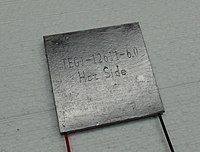
Photo from wikipedia
The microstructure of the half-Heusler phase separation in half-Heusler (HH) MNiSn(M = Ti, Zr) intermetallic compounds has been investigated systematically in this study. Scanning electron microscopy observations from a range… Click to show full abstract
The microstructure of the half-Heusler phase separation in half-Heusler (HH) MNiSn(M = Ti, Zr) intermetallic compounds has been investigated systematically in this study. Scanning electron microscopy observations from a range of (Tix, Zr1-x)NiSn have revealed the HH single phase at high temperature formed into many HH domains of various HH compositions with different Ti/Zr concentration ratios when x > 0.1. The formation of Ti-rich and Zr-rich HH domains with rather large size (up to several hundred μm in diameter) is thought to originate from a combination of the liquid solidification process and followed by an HH phase decomposition process within a miscibility gap between the TiNiSn and ZrNiSn HH phases. We have noticed that in addition to the mass and size difference based phonon scattering, sharp interfaces between the Ti-rich and Zr-rich HH domains containing high density of misfit dislocations could provide additional phonon scattering centers and reduced thermal conductivity of the alloys. Moreover, the cyclic heat treatment process at temperatures near the HH phase-decomposition's critical temperature could modify the HH domains' microstructure to become more diffuse, coherent with a more comprehensive length scale, and globular shape. These diffuse and coherent Ti-rich HH1/Zr-rich HH2 interfaces can provide an additional enhancement of phonon scattering and thereby result in a more considerable reduction of thermal conductivity than those of relatively less diffuse ones. We anticipate a similar approach of using cyclic heat treatment to modify the microstructure and consequently lead to further enhancement of phonon scattering can also apply to many other thermoelectric alloy systems possessing a miscibility gap.
Journal Title: ACS applied materials & interfaces
Year Published: 2021
Link to full text (if available)
Share on Social Media: Sign Up to like & get
recommendations!